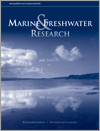Marine and Freshwater Research
Volume 75
Number 10 2024
This study has shown how river regulation in the northern Murray–Darling Basin affects platypus populations, altering their habitats and food sources. Through trapping and DNA analysis, researchers found platypuses struggling downstream of dams, with potential local extinctions upstream, possibly with no access to drought refugia. The findings call for improved river management to safeguard these unique creatures and their ecosystems.
This article belongs to the collection Environmental Flows in Northern Murray–Darling Basin: what we know about the science and management after a decade of practice.
Tropical freshwater fish assemblages monitored in Kakadu National Park were measured using underwater videography, and counted by trained human observers and artificial intelligence (AI). Over 3 years of monitoring, both AI and trained human observers detected the same changes in overall fish assemblage composition. However, AI consistenly underestimated the abundance of small-growing schooling fish. Image credit: Andrew Jansen.
This article belongs to the collection Ecological Monitoring and Assessment of Freshwater Ecosystems: New Trends and Future Challenges.
We introduced a novel method for the use of microorganisms as indicators of sewage-disposal impact in eight coastal lagoons that vary in marine influence and different degrees of anthropogenic pressure. We classified those environments on the basis of the microprotozooplankton community by using indicator species and our classification aligned with the eutrophication status and the known conservation scenario of each lagoon. This method showed potential as a tool for environmental monitoring.
We aimed at determining whether land use impairs the functional and taxonomic diversity of benthic macroinvertebrates in rivers in agricultural lands of Argentina. Functional diversity was more sensitive than taxonomic diversity to environmental stress. Our results highlighted the importance of including functional traits in environmental monitoring programs.
The first study on exploitation levels and population dynamics of a poorly known migratory fish (Megalops cyprinoides) based on samples collected from the south-western coast of India showed habitat-related (marine, estuarine and freshwater) variations in growth patterns. Fishing mortality was the greatest in the length range of 25–30 cm, indicating a higher fishing pressure on immature individuals.
Quantifying flow-related movements of Murray cod and golden perch subject to differing levels of flow regulation is important for water management decision-making. Our study observed that movement patterns for either species were driven by combinations of discharge, river regulation, season, and body size. Tailored management strategies for these fish species should be developed on the basis of location, river regulation and flow regime.
This article belongs to the collection Environmental Flows in Northern Murray–Darling Basin: what we know about the science and management after a decade of practice.
Dryland wetland vegetation is both highly sensitive and remarkably resilient to environmental change. In the short term, this includes rapid responses to wetting and drying. Over extended periods, these ecosystems recover impressively from major environmental disturbances such as mega-droughts or wildfire. As the effects of climate change intensify, the resilience of dryland wetlands will be challenged, leading to scenarios of persistence, transformation or disappearance. With a focus on Australia’s northern Murray–Darling Basin, we explore the wetland policy and management implications.
This article belongs to the collection Environmental Flows in Northern Murray–Darling Basin: what we know about the science and management after a decade of practice.
Underwater vegetation is critical to protect clear-water shallow lakes. However, agriculture has increased nutrients levels in lakes, and with introduced fish and weeds this has led to the degradation of many lakes with loss of underwater plants. Restoration efforts often reduce nutrients and control fish, but seldom re-establish underwater vegetation. We focus on selecting lakes with suitable habitat, which plant species to use and improving bottom sediments, enabling re-establishment of underwater vegetation leading to a return of desired lake condition.
This article belongs to the collection Ecology and Management of Aquatic Macrophytes.
Satellite telemetry enables the study of marine species where observation is difficult owing to their movement across oceans. Rio Lady, a mature female whale shark, has been tracked for longer than any other whale shark and has generated movement data for more than four consecutive years, providing insight into the interannual movement patterns for this species. The combination of these data with machine-learning and habitat-modelling techniques provides a new framework, with potential for enabling new methods of conservation.






